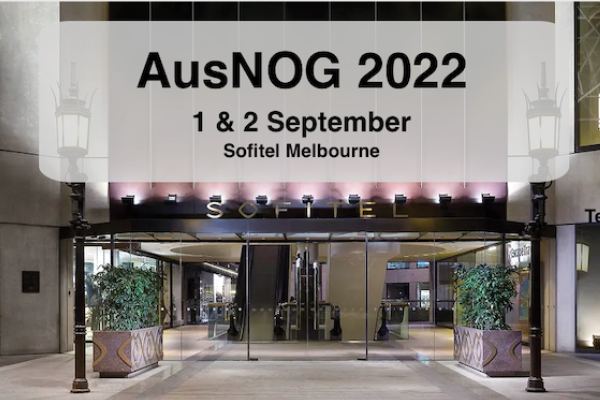IAA Newsletters
The countdown is on for our second IAASysters program. We’ve changed the workshop’s content slightly this year, so attendees get more career planning and presentation skills training.
The sessions will be delivered by prominent industry professionals: Cheryl Alderman from Be Ultimate Coaching will run the Career Planning session. The session Cheryl ran earlier this year received overwhelmingly positive feedback from attendees, so we are very pleased Cheryl is able to join us again. Sarah Denholm from Improve Your Public Speaking will join us for the first time, running the Presentation Skills session. We’re looking forward to hearing from them both!
All attending staff are looking forward to meeting the next group of Systers and hope they will enjoy the workshop and AusNOG Conference. If you see the Systers around the conference – they will likely be the ones wearing the IAASyters t-shirts – feel free to say “hi” and introduce yourself.
Read More
This month’s Meet the Member segment features another fantastic board member, Richard Thompson. Richard currently works as Cloudflare’s Engineering Manager, focusing on the edge network and backbone. He first joined IAA in November 2020 when he moved back into the region after living abroad and wanted an opportunity to get to know and work with the local Internet community. The opportunity to work with a group of like-minded individuals to improve the Internet ecosystem in Australia was one that he jumped at!
Richard’s journey into the industry began as an avid gamer, which sparked his interest in IT. Not knowing specifically what he wanted to do, he decided to start with a broad degree encompassing programming, networking, systems administration and a few other areas. From there, he decided that networking was something he wanted to pursue further, and these days most networking roles have elements of programming intertwined – a happy coincidence.
His career began while he was at university, working at a small ISP in Christchurch, New Zealand, called Snap Internet. He worked his way from a residential helpdesk role to a network engineering role, where he was heavily involved in building the national backbone. In 2015, he left for London, UK, where he took up a network engineering position with Cloudflare and has been there ever since. He thoroughly enjoys working for Cloudflare as he says it’s an exciting ride, and he’s watched the Cloudflare network grow from a handful of data centres to a network that spans hundreds of cities worldwide. He says, “building out a global backbone has been both challenging and rewarding… I find it rewarding seeing our team grow and succeed.”
Currently living in Christchurch, Richard enjoys exploring the outdoors with his fiancée and beloved rescue dog. One of his favourite pastimes is travelling and visiting new places, which he says is one of the reasons he enjoyed London so much – being able to jump on a short flight and be visiting somewhere quite different was amazing! It’s very different being back in New Zealand, but he assures us that there’s still plenty of exploring to be done both in New Zealand and on our beautiful big island, too.
Read More
This year we will be continuing our tradition of running state based end of year member events. We’re opening registrations early this year, and if you would like to attend the event in your state, head over to the member portal to register.
End of Year Events:
Perth – Tuesday, 29 November 2022
MV River Bells Cocktail Cruise
Time: 5:45pm AWST – boarding commences, 6:00pm – 9:00pm AWST – cruise
Location: Barrack Street Jetty
Sydney – Thursday, 1 December 2022
End of Year Member Social
Time: 7:00pm AEDT
Location: The Sporting Globe x 4 Pines, King St Wharf
Adelaide – Wednesday, 7 December 2022
End of Year Member Social
Time: 5:30pm ACDT
Location: The Gallery, 30 Waymouth St, Adelaide
Melbourne – Thursday, 8 December 2022
End of Year Member Social
Time: 5:30pm AEDT
Location: TBC
Brisbane – Wednesday, 14 December 2022
End of Year Member Social
Time: 5:30pm AEST
Location: Pig ‘N’ Whistle Riverside, Riverside Centre, 123 Eagle Street, Brisbane
Read More
Last week we held our first online event for 2022! We hosted this event as we wanted to give our members an idea of how this can be done without breaking the bank, as regulatory compliance usually comes at a significant cost for those who have to comply. We were fortunate to have a panel of experts and a last minute extra – from the Australian Federal Police – who discussed lawful intercept in Australia and the Open LI project from across the ditch.
The session kicked off with an introduction from Narelle Clark and moved quickly into Sophia Joo’s session. She provided an overview of how lawful interception works in Australia, including important information about the Telecommunications (Interception and Access) Act 1979, the lawful intercept process, what your obligations are under the Act and began discussion on the cost of compliance. Richard Nelson followed on being the first of three panellists to discuss the Open LI project – a collaboration between the University of Waikato and industry participants – and how it got started. Shane Alcock – the Lead Software Developer for the project – provided an excellent technical overview of the project, and Dave Mill gave us practical insight into how to implement Open LI in an ISP and turn Shane’s software into something that gets everything you need done. The AFP representative, Mark Parncutt, helped to field questions giving attendees helpful and insightful information on lawful intercept here in Australia. The session ended with a useful discussion based on the audience’s questions.
Despite the event going well, we did run into a technical glitch prior to the event start with a Zoom feature, whereby it requested some registered attendees to register again. We apologise to those who missed it due to this unfortunate occurrence and can reassure everyone that careful testing was undertaken prior to the event, so it happened despite our best efforts. Thankfully, we recorded the session, which can be accessed via our YouTube channel.
Read More
A few months back, one of our staff members caught up with Gavin Tweedie, IAA/WAIA’s first ever employee! Gavin was WA-IX’s Peering Engineer from 2000-2006, before moving to iiNet as a Network Engineer for eight years. His latest role is with Megaport as the Product Manager of Interconnection.
Gavin first became involved with WA-IX as a member of WAIA during his time working for Netway. He saw the role of a Technical Manager being advertised and approached the Committee to find out more. Attending University at the time, completing a Computer Science degree and feeling as though he wasn’t learning much, Gavin wanted to get out and start working. Everything went well with the Committee; he secured the Technical Manager role, and the rest is history!
When asked what he thought WA-IX has achieved for Australia’s internet, his response was “that it still exists”. Gavin explained that in the early 2000s, there were a number of state-based exchanges, and WA-IX was the one that survived. He attributes its success to a few things: a tight-knit community, large enough to require staff, that it fostered friendly competition, advocacy, and distance. A tight-knit community meant that the IX had adequate community support. As the IX grew, you no longer had to rely on the goodwill of your competitors to help you out (in the earlier days, WA-IX ran on volunteers that often worked for competing organisations). However, working with others that worked for competing organisations helped to foster a friendly competitive environment and encouraged community cooperation. The advocacy efforts have continued to build a lot of goodwill for the Association in the industry, and lastly, distance. As we all know, the wholesale costs for transit in the earlier days were a function of how far away you were from the content you wanted to access. The Association’s value was even higher, saving members money, and we now have exchanges thriving in almost every capital city.
Gavin hopes to see WA-IX continue to do what it’s doing and not lose its focus on technical services or its WA roots. He also hopes to see the continuation of the Association’s support of important industry-specific events such as APRICOT.
Read More
Under a new carrier licence condition and determination for eligible CSPs, telcos must provide the CISC with operational information in relation to their telecommunications assets, so it can be included in a register by 7 October 2022. Where an entity other than a carrier or eligible CSP holds a direct interest of at least 10% or a controlling stake in an asset, information about the interest and control in the asset must also be reported.
An ‘asset’ is defined to be a tangible asset owned or operated by a carrier/eligible carriage service provider and is used to supply a carriage service. It does not refer to equipment on customers’ premises. According to industry de-briefs, an asset can be thought of by way of an analogy – the entire car as opposed to the individual components that make up the motor vehicle.
Please visit the CISC website for further information.
Read More
We’re back at AusNOG again this year with quite a few of our team attending, including some new faces for the booth to greet you all. We’ve got a new funky 90’s themed give away t-shirt, so be sure to stop by and say hello. We always enjoy catching up with members.
Read More
NBN Co is now working on the revised Standard Access Undertaking after withdrawing its previous SAU, which was met with industry-wide criticism in late July.
Its discussion paper released earlier this month is a lot more promising and includes a number of changes that which industry has been largely supportive of, notwithstanding remaining concerns on issues such as potential price rises, transparency surrounding NBN Co’s costs, and industry’s expectations for service standards commensurate to capex and thus increase in prices for RSPs.
The ACCC held an industry forum from 18-19 August to which IAA and various other industry representatives were invited. The forum allowed for open and frank discussions and was a great chance for industry to address remaining issues.
NBN Co hopes to release its revised SAU in late October. Submissions for its discussion paper outlining its proposed changes are due on 2 September.
Check out IAA’s media release in response to NBN Co’s SAU withdrawal in July, highlighting our position.







